A Multi-Disciplinary Optimization Approach to Eco-Friendly Design Using the Response Surface Method
Abstract
1. Introduction
2. Materials and Methods
2.1. Life-Cycle Assessment
2.2. Response Surface Method
2.3. Genetic Algorithm
2.4. Multi-Disciplinary Optimization Method
- For the environmental impacts, assessment data for products with the same specifications are obtained through the bill of material (BOM) and then LCA software is used for the environmental impact evaluation;
- To determine the mechanical strength, the mechanical properties are analyzed using CAD software. The corresponding von Mises stress data from step 1 are adopted as the references for the mechanical strength calculation;
- With the help of the RSM, the data acquired in steps 1 and 2 are used to construct two models, namely the environmental impact function () and mechanical strength function (). As previously mentioned, regression models can be classified into three types. Therefore, it is necessary to derive and compare models of all three types to select the one with the lowest error rate for the subsequent multi-disciplinary and MOO;
- First, and are combined into a multi-objective function, . Next, the GA is applied for numerical optimization. Yet, because the two functions are different in nature and show opposite trends, normalization is needed before the optimization, as illustrated in Equations (1) and (2). The first equation divides each objective function by its maximum value. In the meantime, Equation (2) first computes the absolute value of the difference between each function and its minimum value and then divides the absolute value by the difference between the maximum and the minimum. After normalization, and are assigned different weights for optimization. The objective functions are given as Equations (3) and (4), which are weighted equations of Equations (1) and (2), respectively.
3. Results
4. Discussion
5. Conclusions
Supplementary Materials
Author Contributions
Funding
Institutional Review Board Statement
Informed Consent Statement
Data Availability Statement
Conflicts of Interest
Abbreviations
| CAD | Computer-Aided Design |
| LCA | Life-Cycle Assessment |
| Em-LCA | Energy-based Life-Cycle Assessment |
| CNC | Computer Numerical Control |
| DFA | Design For Assembly |
| EoLCl | End-of-Life Contamination Index |
| LCI | Life-Cycle Inventory |
| GA | Genetic Algorithm |
| MOO | Multi-Objective Optimization |
| RSM | Response Surface Method |
| MOGA | Multi-Objective Genetic Algorithm |
| BPNNs | Back Propagation Neural networks |
| PT | Point |
| BOM | Bill Of Material |
| ABS | Acrylonitrile Butadiene Styrene |
| PS | Polystyrene |
| LCD | Liquid-Crystal Display |
References
- Slama, H.B.; Gaha, R.; Benamara, A. Proposal of new eco-manufacturing feature interaction-based methodology in CAD phase. Int. J. Adv. Manuf. Technol. 2020, 106, 1057–1068. [Google Scholar] [CrossRef]
- Jiang, Q.; Liu, Z.C.; Li, T.; Cong, W.; Zhang, H.C. Emergy-based life-cycle assessment (Em-LCA) for sustainability assessment: A case study of laser additive manufacturing versus CNC machining. Int. J. Adv. Manuf. Technol. 2019, 102, 4109–4120. [Google Scholar] [CrossRef]
- Suhariyanto, T.T.; Wahab, D.A.; Rahman, M.N.A. Product Design Evaluation Using Life Cycle Assessment and Design for Assembly: A Case Study of a Water Leakage Alarm. Sustainability 2018, 10, 2821. [Google Scholar] [CrossRef]
- Aguiar, J.D.; Oliveira, L.D.; Silva, J.O.D.; Bond, D.; Scalice, R.K.; Becker, D. A design tool to diagnose product recyclability during product design phase. J. Clean. Prod. 2017, 141, 219–229. [Google Scholar] [CrossRef]
- Hischier, R. Life cycle assessment study of a field emission display television device. Int. J. Life Cycle Assess. 2015, 20, 61–73. [Google Scholar] [CrossRef]
- Bhakar, V.; Agur, A.; Digalwar, A.K.; Sangwan, K.S. Life Cycle Assessment of CRT, LCD and LED Monitors. Procedia CIRP 2015, 29, 432–437. [Google Scholar] [CrossRef]
- Ng, C.Y.; Lam, S.S.; Choi, S.P.M.; Law, K. Optimizing green design using ant colony-based approach. Int. J. Life Cycle Assess. 2020, 25, 600–610. [Google Scholar] [CrossRef]
- Ferdosian, I.; Camões, A. Eco-efficient ultra-high performance concrete development by means of response surface methodology. Cem. Concr. Compos. 2017, 84, 146–156. [Google Scholar] [CrossRef]
- Zhang, C.; Liu, Y.; Qian, Y.H. An optimization framework of electric vehicle (EV) batteries for product eco-design. Procedia CIRP 2020, 90, 366–371. [Google Scholar] [CrossRef]
- Taha, Z.; Gonzales, J.; Novita, S.; Ariffin, R.; Ghazila, R.; Rashid, S.A. Optimization of Product Design to Reduce Environmental Impact of Machining. Ind. Eng. Manag. Syst. 2011, 10, 128–133. [Google Scholar] [CrossRef][Green Version]
- Zhu, X.; Ho, C.H.; Wang, X. Application of Life Cycle Assessment and Machine Learning for High-Throughput Screening of Green Chemical Substitutes. ACS Sustain. Chem. Eng. 2020, 8, 11141–11151. [Google Scholar] [CrossRef]
- Hafeez, A.; Taqvi, S.A.A.; Fazal, T.; Javed, F.; Khan, Z.; Amjad, U.S.; Bokhari, A.; Shehzad, N.; Rashid, N.; Rehman, S.; et al. Optimization on cleaner intensification of ozone production using Artificial Neural Network and Response Surface Methodology: Parametric and comparative study. J. Clean. Prod. 2020, 252, 119833. [Google Scholar] [CrossRef]
- Li, C.J.; Fang, Y.C.; Cheng, M.C. Study of optimization of an LCD light guide plate with neural network and genetic algorithm. Opt. Express 2009, 17, 1017–10188. [Google Scholar] [CrossRef]
- Khalid, M. Investigation of Additive Manufacturing Process Parameters for Sustainability to Optimize Energy and Material Consumption. Master’s Thesis, University of Manitoba, Winnipeg, MB, Canada, 2020. [Google Scholar]
- Sivaiah, P.; Chakradhar, D. Analysis and Modeling of Cryogenic Turning Operation Using Response Surface Methodology. Silicon 2018, 10, 2751–2768. [Google Scholar] [CrossRef]
- Sivaiah, P.; Chakradhar, D. Modeling and optimization of sustainable manufacturing process in machining of 17-4 PH stainless steel. Measurement 2019, 134, 142–152. [Google Scholar] [CrossRef]
- Zhou, C.C.; Yin, G.F.; Hu, X.B. Multi-objective optimization of material selection for sustainable products: Artificial neural networks and genetic algorithm approach. Mater. Des. 2009, 30, 1209–1215. [Google Scholar] [CrossRef]
- Julirose, G. Genetic Algorithm Optimization of Product Design for Environmental Impact Reduction. Ph.D. Thesis, University of Malaya, Kuala Lumpur, Malaysia, 2018. [Google Scholar]
- Zhai, Y.; Wang, Y.; Huang, Y.; Meng, X. A multi-objective optimization methodology for window design considering energy consumption, thermal environment and visual performance. Renew. Energy 2019, 134, 1190–1199. [Google Scholar] [CrossRef]
- Wang, S.; Xiao, J.; Wang, J.; Jian, G.; Wen, J.; Zhang, Z. Application of response surface method and multi-objective genetic algorithm to configuration optimization of Shell-and-tube heat exchanger with fold helical baffles. Appl. Therm. Eng. 2018, 129, 512–520. [Google Scholar] [CrossRef]
- Cao, B.; Yuan, Y.; Arman, Y.; Feng, L.; Zhou, Z.; Wang, T.; Wang, Q. Optimization of Halbach magnetic roller for eddy current separation based on the response surface method and multi-objective genetic algorithm. J. Clean. Prod. 2021, 278, 123531. [Google Scholar]
- Lim, S.R.; Kim, Y.R.; Woo, S.H.; Park, D.; Park, J.M. System optimization for eco-design by using monetization of environmental impacts: A strategy to convert bi-objective to single-objective problems. J. Clean. Prod. 2013, 39, 303–311. [Google Scholar] [CrossRef]
- Deng, C.; Wu, J.; Shao, X. Research on eco-balance with LCA and LCC for mechanical product design. Int. J. Adv. Manuf. Technol. 2016, 87, 1217–1228. [Google Scholar] [CrossRef]
- Kluczek, A. An energy-led sustainability assessment of production systems—An approach for improving energy efficiency performance. Int. J. Prod. Econ. 2019, 216, 190–203. [Google Scholar] [CrossRef]
- Baptista, A.J.; Peixoto, D.; Ferreira, A.D.; Pereira, J.P. Lean Design-for-X Methodology: Integrating Modular Design, Structural Optimization and Ecodesign in a Machine Tool Case Study. Procedia CIRP 2018, 69, 722–727. [Google Scholar] [CrossRef]
- Chiang, T.A.; Che, Z.H. A decision-making methodology for low-carbon electronic product design. Decis. Support Syst. 2015, 71, 1–13. [Google Scholar] [CrossRef]
- Taghdisian, H.; Pishvaie, M.R.; Farhadi, F. Multi-objective optimization approach for green design of methanol plant based on CO2-efficeincy indicator. J. Clean. Prod. 2015, 103, 640–650. [Google Scholar] [CrossRef]
- Mele, M.; Campana, G. Sustainability-driven multi-objective evolutionary orienting in additive manufacturing. Sustain. Prod. Consum. 2020, 23, 138–147. [Google Scholar] [CrossRef]
- ISO 14040:2006; Environmental Management—Life Cycle Assessment—Principles and Framework. Available online: https://www.iso.org/standard/37456.html (accessed on 17 February 2022).
- Goedkoop, M.J. The Eco-Indicator 99 a Damage Oriented Method for Life Cycle Impact Assessment Methodology Report; Pre Concultants: Amersfoort, The Netherlands, 1999. [Google Scholar]
- Goldberg, D.E. Genetic Algorithms in Search, Optimization and Machine Learning; Addison-Wesley: Boston, MA, USA, 1989. [Google Scholar]
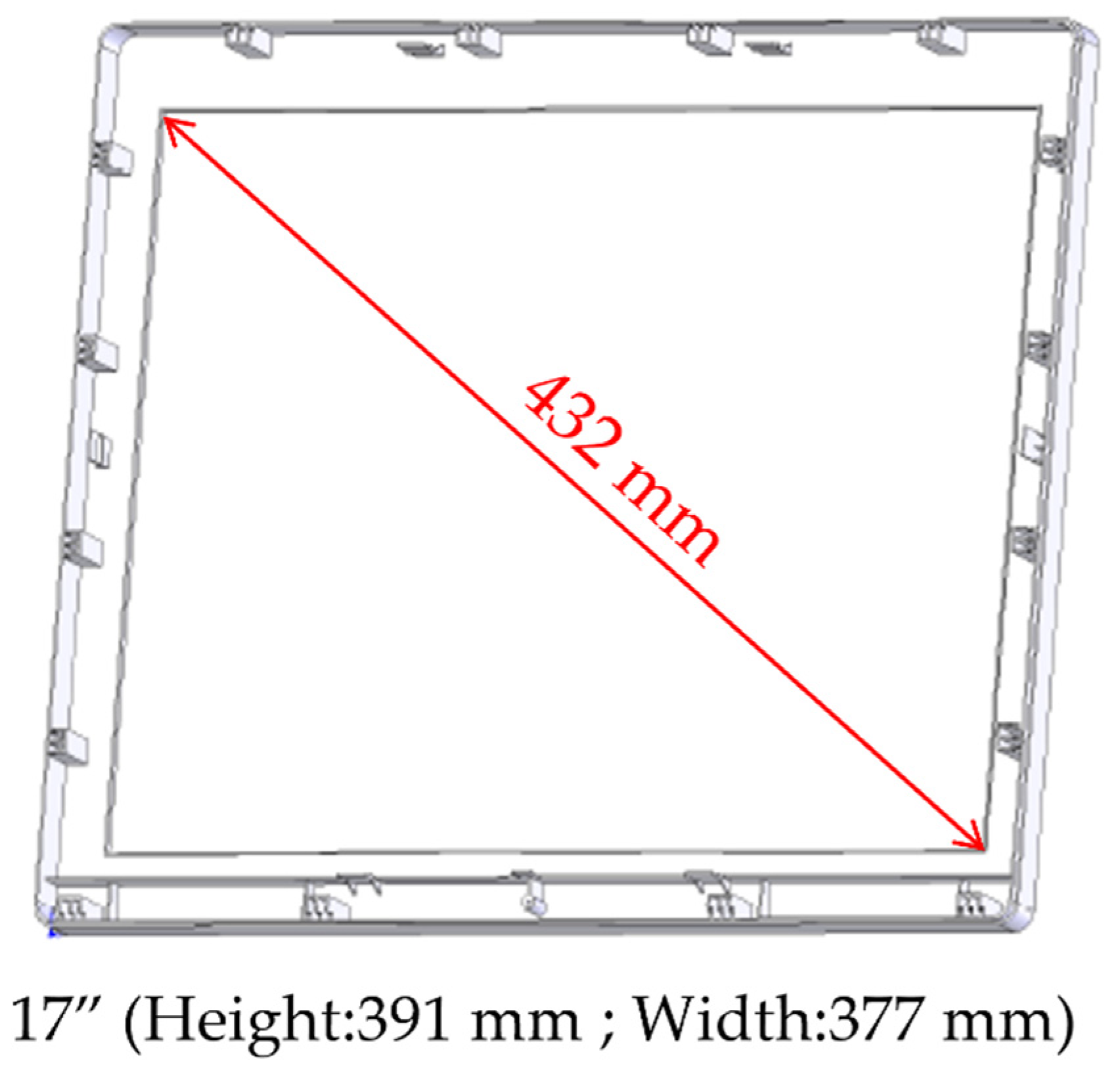

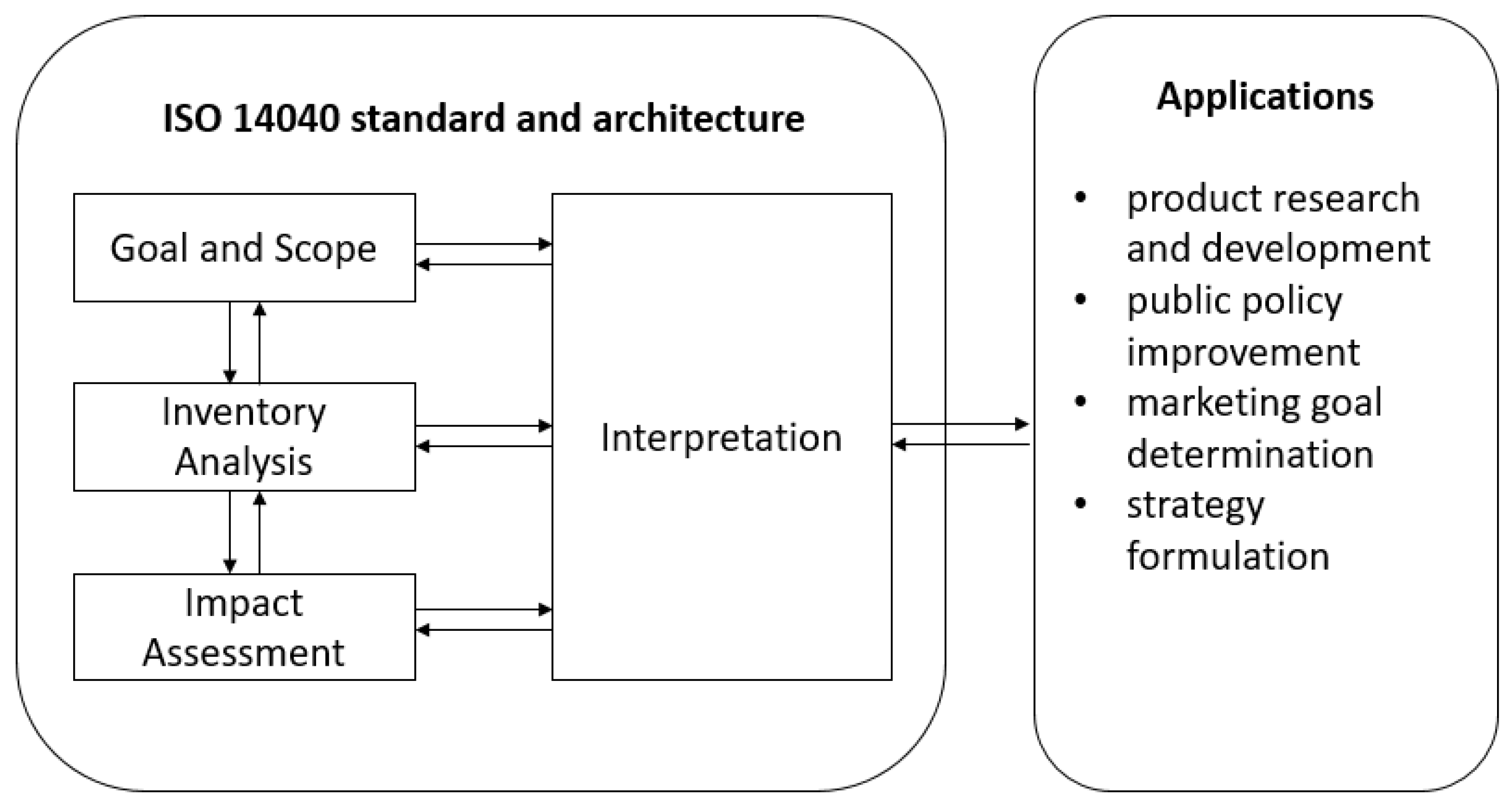
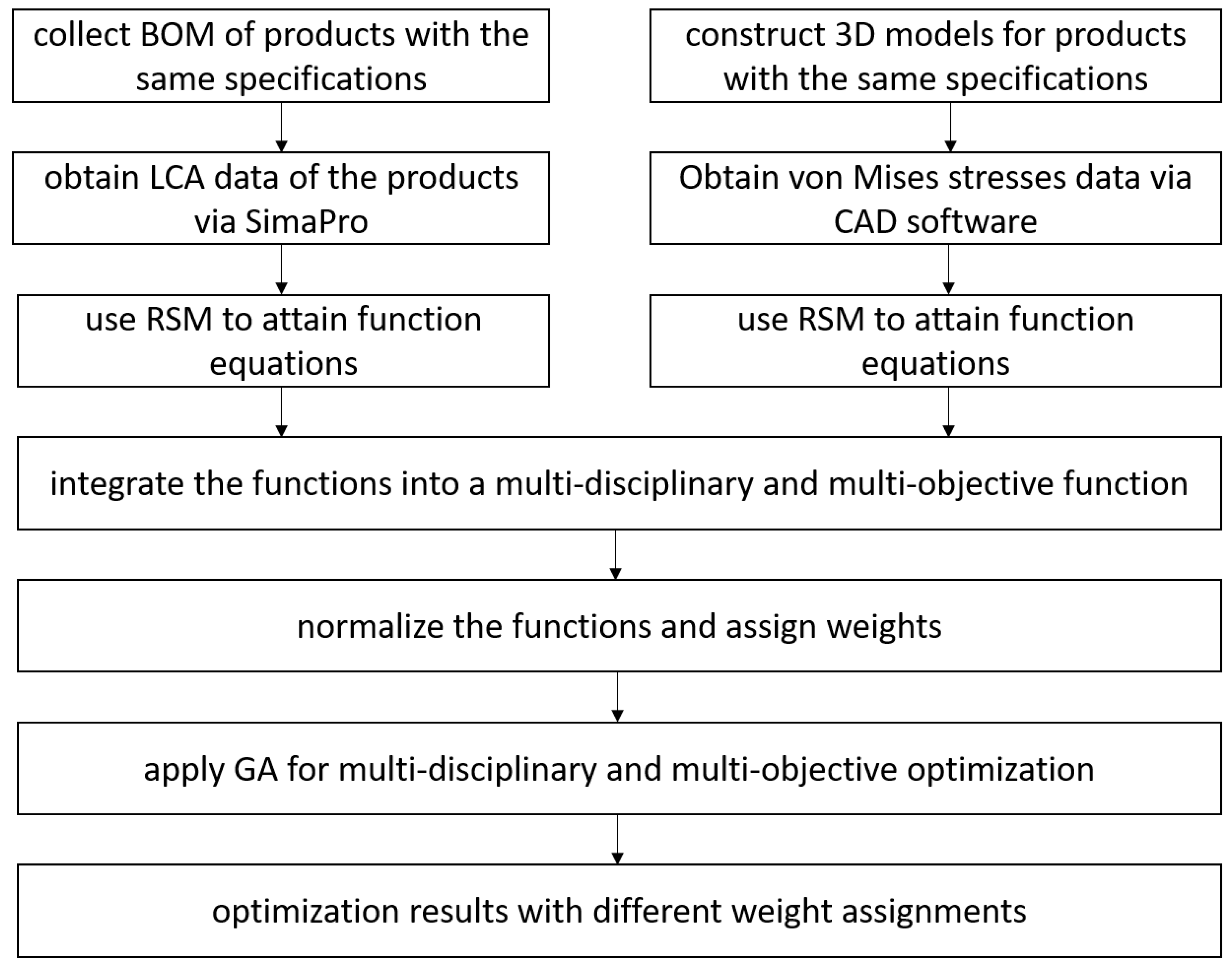
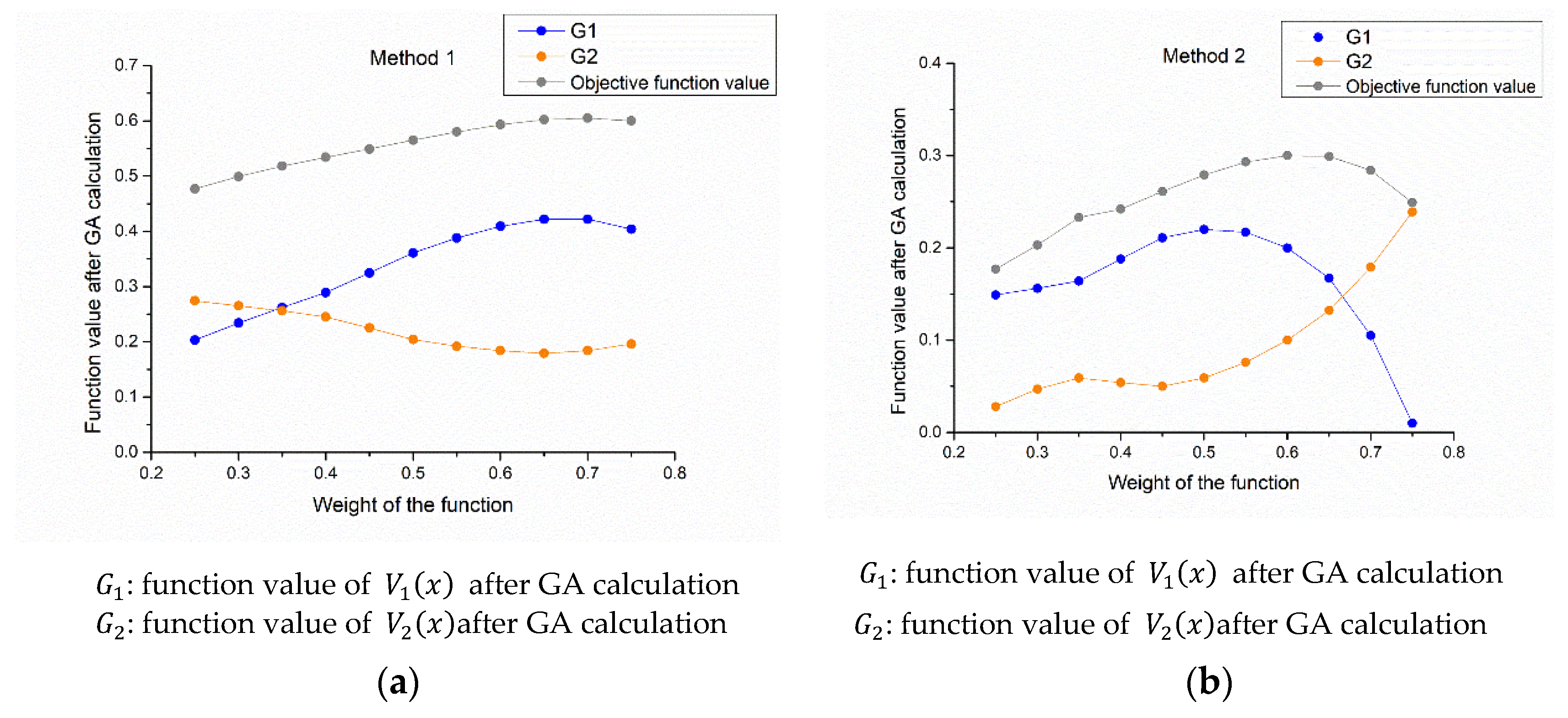
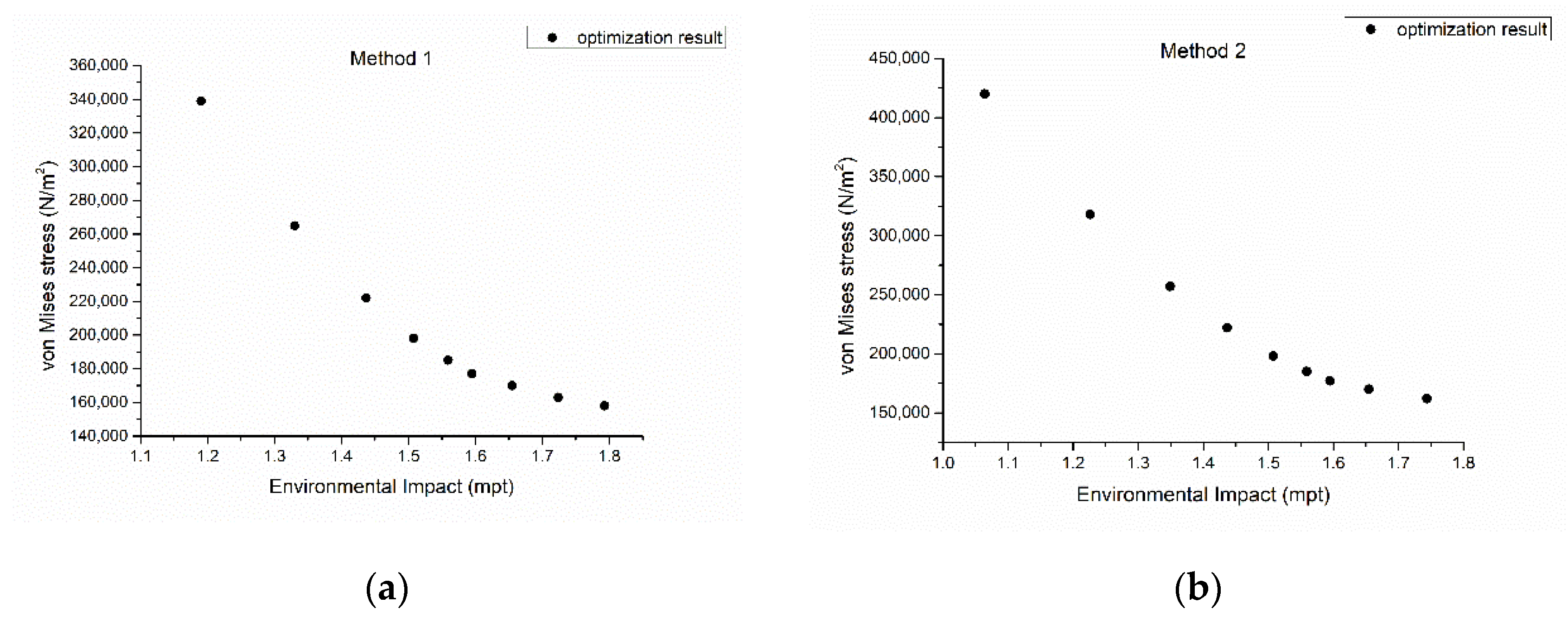
| ID | Parameter | Value |
|---|---|---|
| display surface thickness | 0.2 mm, 0.25 mm, 0.3 mm, 0.35 mm, 0.4 mm | |
| outer layer thickness of the frame | 0.2 mm, 0.25 mm, 0.3 mm, 0.35 mm, 0.4 mm | |
| material | 1 (ABS), 2 (PS) | |
| use of fossil fuels | 1.05 mpt~2.21 mpt |
| ID | Parameter | Value |
|---|---|---|
| display surface thickness | 0.2 mm, 0.25 mm, 0.3 mm, 0.35 mm, 0.4 mm | |
| outer layer thickness of the frame | 0.2 mm, 0.25 mm, 0.3 mm, 0.35 mm, 0.4 mm | |
| material | 1 (ABS), 2 (PS) | |
| von Mises stress | ) |
| Gene Code ID | Gene Code Length | Actual Range |
|---|---|---|
| 5 | 0.2 mm~0.4 mm | |
| 5 | 0.2 mm~0.4 mm | |
| 2 | 1, 2 |
| Method | Objective Function Value | Environmental Impact (mpt) | ||||||||
|---|---|---|---|---|---|---|---|---|---|---|
| 1 | 0.25 | 0.75 | 0.203 | 0.274 | 0.477 | 0.400 | 0.329 | 1 | 1.7931 | 1.5813 × 105 |
| 1 | 0.3 | 0.7 | 0.234 | 0.265 | 0.499 | 0.400 | 0.284 | 1 | 1.7238 | 1.6334 × 105 |
| 1 | 0.35 | 0.65 | 0.262 | 0.256 | 0.518 | 0.400 | 0.239 | 1 | 1.6546 | 1.6989 × 105 |
| 1 | 0.4 | 0.6 | 0.289 | 0.245 | 0.534 | 0.400 | 0.200 | 1 | 1.5946 | 1.7664 × 105 |
| 1 | 0.45 | 0.55 | 0.325 | 0.225 | 0.549 | 0.400 | 0.200 | 1 | 1.5946 | 1.7664 × 105 |
| 1 | 0.5 | 0.5 | 0.361 | 0.204 | 0.565 | 0.400 | 0.200 | 1 | 1.5946 | 1.7664 × 105 |
| 1 | 0.55 | 0.45 | 0.388 | 0.192 | 0.580 | 0.387 | 0.200 | 1 | 1.5593 | 1.8464 × 105 |
| 1 | 0.6 | 0.4 | 0.409 | 0.184 | 0.593 | 0.368 | 0.200 | 1 | 1.5076 | 1.9849 × 105 |
| 1 | 0.65 | 0.35 | 0.422 | 0.179 | 0.602 | 0.342 | 0.200 | 1 | 1.4367 | 2.2158 × 105 |
| 1 | 0.7 | 0.3 | 0.422 | 0.184 | 0.605 | 0.303 | 0.200 | 1 | 1.3301 | 2.6521 × 105 |
| 1 | 0.75 | 0.25 | 0.404 | 0.196 | 0.600 | 0.252 | 0.200 | 1 | 1.1905 | 3.3851 × 105 |
| 2 | 0.25 | 0.75 | 0.149 | 0.028 | 0.177 | 0.400 | 0.297 | 1 | 1.7438 | 1.6170 × 105 |
| 2 | 0.3 | 0.7 | 0.156 | 0.047 | 0.203 | 0.400 | 0.239 | 1 | 1.6546 | 1.6989 × 105 |
| 2 | 0.35 | 0.65 | 0.164 | 0.059 | 0.233 | 0.400 | 0.200 | 1 | 1.5946 | 1.7664 × 105 |
| 2 | 0.4 | 0.6 | 0.188 | 0.054 | 0.242 | 0.400 | 0.200 | 1 | 1.5946 | 1.7664 × 105 |
| 2 | 0.45 | 0.55 | 0.211 | 0.05 | 0.261 | 0.400 | 0.200 | 1 | 1.5946 | 1.7664 × 105 |
| 2 | 0.5 | 0.5 | 0.220 | 0.059 | 0.279 | 0.387 | 0.200 | 1 | 1.5593 | 1.8464 × 105 |
| 2 | 0.55 | 0.45 | 0.217 | 0.076 | 0.293 | 0.368 | 0.200 | 1 | 1.5076 | 1.9849 × 105 |
| 2 | 0.6 | 0.4 | 0.200 | 0.100 | 0.300 | 0.342 | 0.200 | 1 | 1.4367 | 2.2158 × 105 |
| 2 | 0.65 | 0.35 | 0.167 | 0.132 | 0.299 | 0.310 | 0.200 | 1 | 1.3493 | 2.5658 × 105 |
| 2 | 0.7 | 0.3 | 0.105 | 0.179 | 0.284 | 0.265 | 0.200 | 1 | 1.2261 | 3.1807 × 105 |
| 2 | 0.75 | 0.25 | 0.01 | 0.239 | 0.249 | 0.206 | 0.200 | 1 | 1.0642 | 4.2043 × 105 |
Publisher’s Note: MDPI stays neutral with regard to jurisdictional claims in published maps and institutional affiliations. |
© 2022 by the authors. Licensee MDPI, Basel, Switzerland. This article is an open access article distributed under the terms and conditions of the Creative Commons Attribution (CC BY) license (https://creativecommons.org/licenses/by/4.0/).
Share and Cite
Yang, C.-J.; Lin, M.J.; Chen, J.L. A Multi-Disciplinary Optimization Approach to Eco-Friendly Design Using the Response Surface Method. Appl. Sci. 2022, 12, 3002. https://doi.org/10.3390/app12063002
Yang C-J, Lin MJ, Chen JL. A Multi-Disciplinary Optimization Approach to Eco-Friendly Design Using the Response Surface Method. Applied Sciences. 2022; 12(6):3002. https://doi.org/10.3390/app12063002
Chicago/Turabian StyleYang, Cheng-Jung, Mei Jyun Lin, and Jahau Lewis Chen. 2022. "A Multi-Disciplinary Optimization Approach to Eco-Friendly Design Using the Response Surface Method" Applied Sciences 12, no. 6: 3002. https://doi.org/10.3390/app12063002
APA StyleYang, C.-J., Lin, M. J., & Chen, J. L. (2022). A Multi-Disciplinary Optimization Approach to Eco-Friendly Design Using the Response Surface Method. Applied Sciences, 12(6), 3002. https://doi.org/10.3390/app12063002







